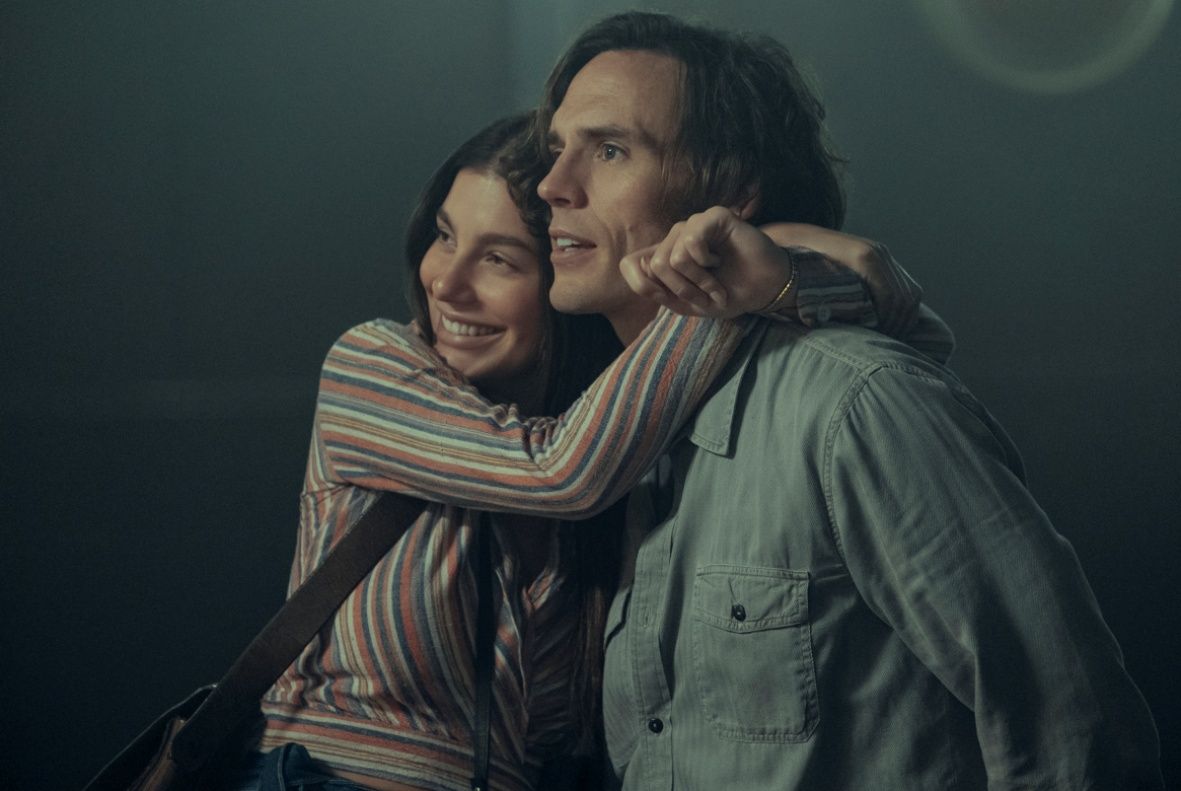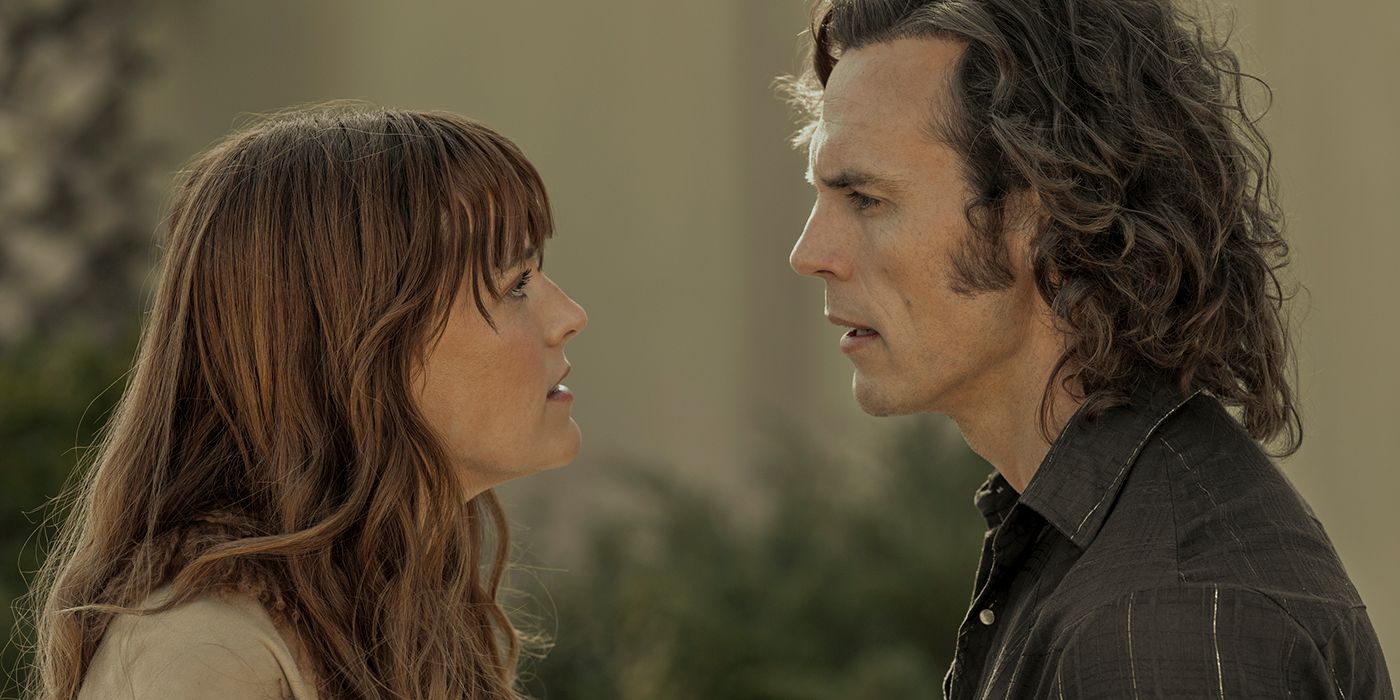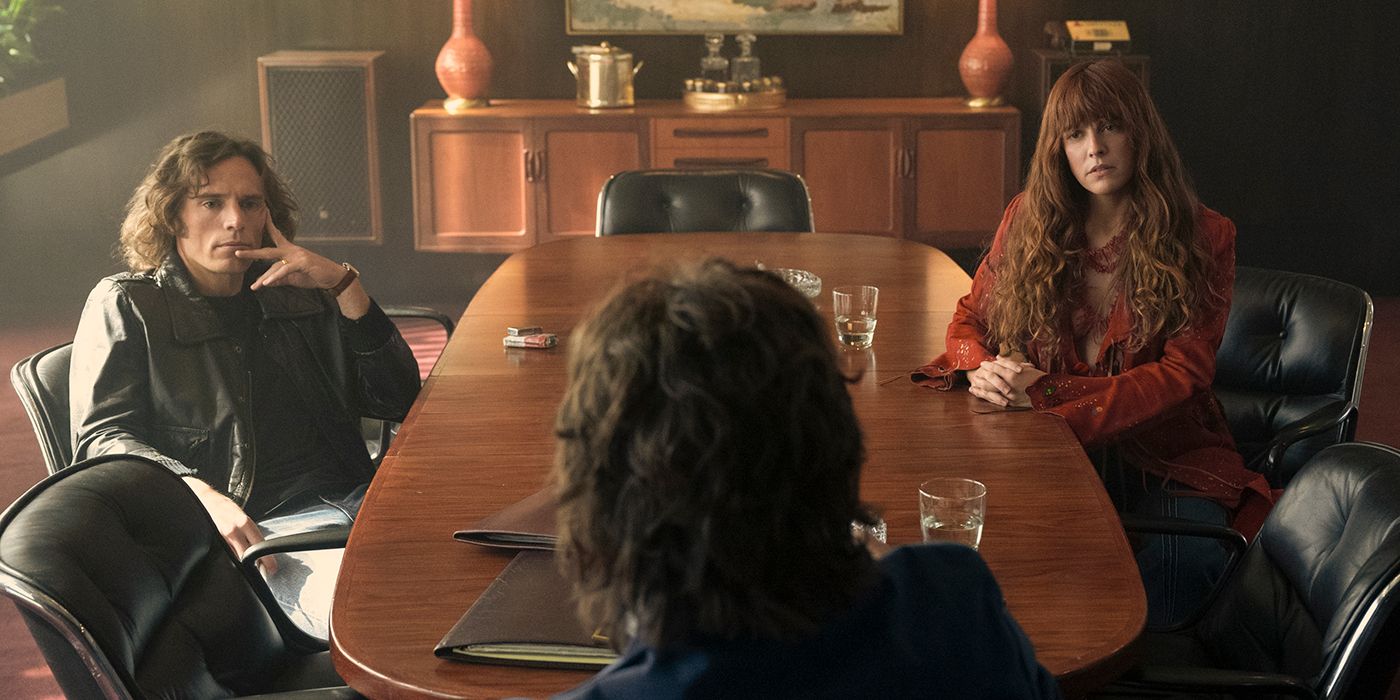‘Daisy Jones and The Six’ Uses Drugs as a Shorthand (and That’s a Problem)
Editor’s Note: The following contains spoilers for Episode 8 of Daisy Jones and The Six.In Episode 6 of Prime Video’s Daisy Jones and the Six, there is a moment in which Billy (Sam Claflin) and Daisy’s (Riley Keough) relationship seems about to make the jump from mutual pining to proper consummation. After days of bonding over music and shared experiences, Daisy takes Billy to her room at the Chateau Marmont. They stand by the door, and sexual tension fills the air as Daisy waits for Billy to come in. Billy looks at Daisy, and then at the drugs and the bottles of alcohol on top of the bar cart by the door. Without saying much, he goes away. Years later, he tells the faceless reporter that is now interviewing the band that he saw just one thing inside that room: temptation. When asked about the same event, Daisy tells the reporter that Billy wasn’t talking about the drugs. Viewers, however, are left to decide by themselves what exactly Billy meant by “temptation”. Was he indeed talking about the drugs? Or was it about Daisy? Or, maybe, it was both.
This conflation of Daisy with drugs isn’t a one-time thing in Daisy Jones and the Six. Whenever it wants to show us Billy’s attraction towards Daisy, the show frequently uses drugs as a shorthand for both desire and destruction – for temptation, as Billy puts it. In scenes meant to imply that Billy is developing feelings for Daisy, he more often ogles not just her, but also some sort of drug she is using, whether it’s a bottle of beer or a line of coke. This makes sense with Billy’s narrative: as a recovering addict, he feels at the same time bothered and enticed by the drugs. It is something that he wants badly, but that he shouldn’t want.
However, the drugs, in Daisy Jones and the Six, aren’t just drugs. They are a stand-in for Daisy herself. As a married man, Billy sees Daisy as yet another thing that he wants badly in spite of his best interest – and the word “thing” was used very deliberately in this sentence. After all, by equating its protagonist with the substances that she uses, Daisy Jones and the Six takes away from her characterization. In the end, Daisy becomes less a person and more of an obstacle that Billy has to overcome.
Billy and Daisy’s Relationship Is Marked by Substance Abuse from the Very Beginning
Drugs are an important part of Billy and Daisy’s relationship from the get-go. It is after Billy’s substance abuse ruins The Six’s first tour that music producer Teddy Price (Tom Wright) suggests a partnership in order for the band to regain the label’s trust. Daisy, whom Teddy had just discovered playing at The Troubadour, is brought in to record “Look at Us Now (Honeycomb)” alongside a newly sober Billy, and the rest is history.
Billy and Daisy don’t hit it off right away. Billy’s more serious, closed-off personality clashes with Daisy’s relaxed, cheerful disposition. Since both of them are so headstrong and unwelcoming to constructive criticism, they argue about music, the rest of the band’s role in the creative process, and about work ethics as a whole. Billy doesn’t want to share the band’s leadership, and Daisy refuses to play second-fiddle to anyone else, let alone to some man looking for backing vocals for his love songs to his wife. But, as it becomes clearer that the future of The Six’s hinges on Daisy joining the band, she and Billy are forced to patch things up.
The first person to give Daisy and Billy a hand toward mutual understanding is Billy’s wife, Camila (Camila Morrone). In Episode 4, she invites Daisy over to a housewarming party in order to get her husband on good terms with his new band mate. In Episode 5, it is time for Teddy to insist that Daisy and Billy work it out before working on the album. The duo does so by breaking into Teddy’s house and engaging in a day-long bonding/songwriting session. In both these instances, Daisy’s use of alcohol and drugs, and Billy’s relationship to those substances come into play. At the party, it is while looking at the beer in Daisy’s hand that Billy notices the wound that she got from trying to break into her parents’ house. It’s a very brief, barely noticeable glance, one that doesn’t mean anything unless you’re looking at it in context. At Teddy’s place, Daisy repeatedly pops pills in Billy’s presence, which prompts him to suggest that she might have an issue. In order to prove him wrong, Daisy flushes her drugs down the toilet.
But it is in Episode 6 that Daisy’s ever-growing substance abuse truly embraces its role in her and Billy’s relationship. Apart from the Chateau Marmont scene with which we opened this article, there is also a moment in which Billy watches Daisy snort a line of coke with a mixture of horror and desire. The scene takes place right before the duo’s drive through LA. Billy and Daisy are recording at the studio when something feels wrong. Remarking that she is hitting a low, Daisy gets up to leave the studio, but Billy tells her to stay. Making a show out of it, Daisy turns to him and snorts cocaine off of the back of her hand. She eyes him defiantly, either challenging him not to be tempted by drugs or by her. Once again, the viewers are left to decide.
Daisy Is Presented as the Perfect Foil for Billy But Forgets to Develop Her as a Character
This association between Daisy and drugs, in Billy’s eyes, makes a certain narrative sense. Daisy is the perfect foil to Billy. She’s not his soulmate, but his mirror, as Nicky (Gavin Drea) so aptly puts it in Episode 7. Yes, the two differ a lot in their dispositions, and their backstories don’t always align with one another, but when it comes to substance abuse, Daisy is sort of a delayed reflection of Billy, going exactly through the same stages of addiction as him, but at a slower pace. Not only that but, despite their differences, Billy still sees a lot of himself in Daisy’s genius, as well as in her commanding and obstinate personality. Watching her go through the motions of drug addiction is a painful process for him because it feels like witnessing himself going through it all over again.
However, by constantly portraying Daisy with a bottle of pills or a bag of cocaine in her hand, Daisy Jones and the Six creates an association between her and the drugs that she uses that goes beyond what Billy sees: it informs the way in which Daisy’s character is perceived by the audience. Daisy is presented as an obstacle for Billy in his search for happiness, both when it comes to his marriage with Camila and when it comes to his still ongoing recovery.
Daisy Jones and the Six forgoes Daisy’s development as a character almost entirely. All we see of her is her addiction, which gets stronger and stronger with each passing episode. Granted, Episode 7 is a welcome change of pace, with its focus on Daisy’s loneliness and the lies that she tells herself. In the end, her infatuation with Nicky is nothing but a form of escapism – through his wealth, his drugs, and, of course, his cohort of completely detached friends. But, overall, we don’t get to see much of how Daisy herself relates to her drug use. As a matter of fact, we don’t know much about her apart from her “poor little rich girl” background. Billy is the one with the story: he has the wife, the troubled past with drugs, and the temptation that is Daisy laid in front of him.
By not fleshing out Daisy as much as Billy, Daisy Jones and the Six allows the events of the show to be seen almost exclusively through Billy’s eyes. Even though the show purports to tell the story of its eponymous bands from the perspective of all its members, it is Billy’s version of events that truly matters. And, in Billy’s version, Daisy is hardly a person: she’s merely a temptation, a threat to his health and well-being. At best, she is a waste of potential. In order to course-correct and get its titular character out of this objectifying position, the series would have to devote more time to her own story, particularly to how she relates to other people, other things, or even to her own drug abuse. Perhaps there is still time for things to change in the upcoming two final episodes. But considering that Daisy had an overdose in Episode 8 and it was still framed from Billy’s point of view, it certainly doesn’t look promising.





